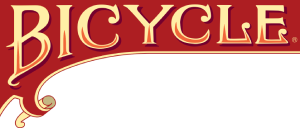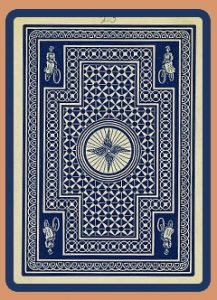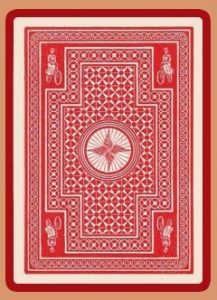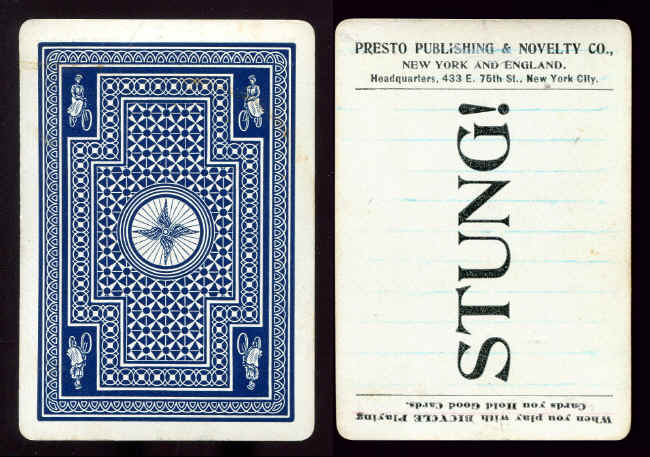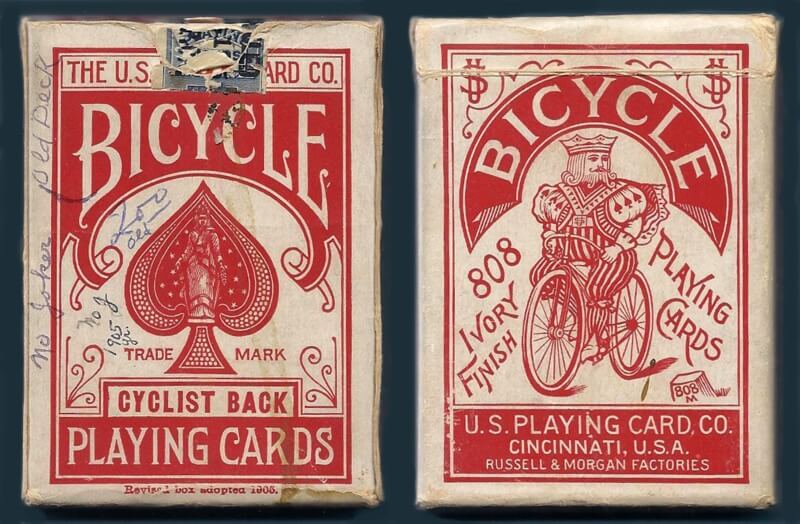Issued in 1908. Discontinued in 1917. Very rare. Blue singles show up from time to time, but red singles and decks of either color are seldom seen.
The single below is what is usually referred to as a throw-out card, a card literally thrown out by a magician into the audience as a souvenir. This one may have been used in a more specific routine in which the card was revealed and the participant was somehow “stung.” For more information on throw-out cards, please visit Propelled Pasteboards.
A red Cyclist No. 2 deck sold on eBay for $384 on May 3, 2017. The deck included the joker and its original box, although the deck itself had some damaged cards. See the last image, below, for a picture of the tuck case. All things considered, $384 was a fair price for such a rare deck accompanied by its joker and original box. What was most interesting about the auction is that there were only three bids: $25, $379 and the winning bid of $384. Had there not been a third bid, the deck would have sold to the underbidder for $26. This illustrates the delicate relationship between auction hammer prices, rarity and the intrinsic value of the cards. The sale price is not always an accurate indicator of rarity, and value remains a constant only in relation to the active interest within the collecting community.
Now, for some interesting information on the “Stung” card pictured below from Tom Ewing.
The Presto Publishing and Novelty Company of New York, the printer of the “Stung” card, was operated by a gentleman named Charles J. Hagen. He was very well known in magic circles and among other things, published a magic magazine out of Philadelphia called The Magic World. He was also the founder of the National Conjurors’ Association (NCA), an early rival to the Society of American Magicians.
The “Stung” card was most likely used in a three card monte effect where there are three playing cards. The center card has a corner of a different card taped on to its surface. The stung card is placed underneath this corner and then the two other cards placed one on each side. The effect would be to show three cards, say two red on each side and a black card in the center. The performer might ask, “Which is different than the others?” The spectator would, of course, choose the center black card. The three cards would be turned face down, the center card pulled out and laid face down on the table, and then the remaining two red cards shown but with the black corner covered. Upon turning over the face down center card and the performer asking again, “Which is different?”, the stung card would come up.
This is a guess, of course. However, the principle of having a playing card with “stung” on it is very well known. Usually, it’s “stung and stung again.” In this effect, again three cards are shown and covered with a silk handkerchief. The magician reaches under the silk and removes one of the red cards and discards it. He then reaches under and removes the second red card and lays it aside. Finally he asks, “Which card is left?” and then when the person says “The black card,” he openly turns the card and silk completely around. The silk is removed and the word “stung” is on the card. The person obviously says, “You turned the card around, show me the back.” Turning the card over it says “Stung again.” The effect is mostly offered with giant cards for platform or stage work. The routine has been around for many, many decades.
SALES DATA
A red Cyclist No. 2 deck sold on eBay for $384 on May 3, 2017 (see the discussion of the circumstances of the auction, above). A red Cyclist No. 2 sample card sold on eBay for $120 on January 18, 2018, continuing the trend of prices for this back design reflecting its rarity.
